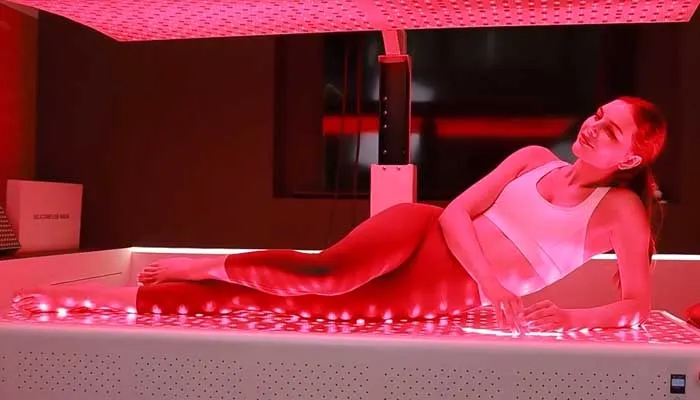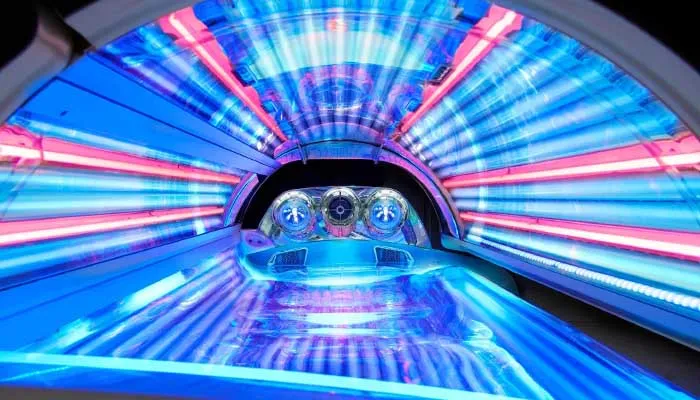Red light therapy (RLT) has gained immense popularity in recent years due to its wide-ranging benefits for skin health, pain relief, and overall well-being. Many people are exploring red light tanning beds near them or investing in at-home devices to experience these benefits. However, with so many options available—red light tanning beds, red light bulbs, or professional therapy booths—how do you decide what’s best for you? This article will explore the benefits of red light therapy, compare the costs of different options, and guide you on converting traditional tanning beds to red light therapy devices.

1. What Is Red Light Therapy?
Red light therapy is a non-invasive treatment that uses specific wavelengths of red and near-infrared light (typically 660 nm and 850 nm) to stimulate cellular activity and promote healing. Unlike traditional tanning beds, which use harmful UV rays to darken the skin, red light therapy doesn’t tan the skin or cause damage.
- How It Works:
Red light penetrates the skin deeply to stimulate mitochondria in your cells, increasing ATP production (cellular energy). This promotes cellular repair, reduces inflammation, and enhances overall skin health. - Common Applications:
- Reducing pain and inflammation.
- Improving skin texture, reducing wrinkles, and treating acne.
- Enhancing muscle recovery and post-workout repair.
- Supporting better sleep and mood regulation.
2. Red Light Therapy vs. Traditional Tanning Beds: What’s the Difference?
When most people hear about red light therapy, they might immediately think of traditional tanning beds. After all, both involve lying in a bed surrounded by lights. But here’s the thing: they’re completely different in terms of how they work, what they do for your body, and whether they’re good for you in the long run. Let’s break it down in a simple, easy-to-follow way.
2.1 What Do They Do?
- Traditional Tanning Beds:
Tanning beds emit UV (ultraviolet) light, which triggers your skin to produce melanin. This is what gives you a tan. While it might make you look like you just came back from a vacation, UV light can be harmful. It damages your skin over time, causing wrinkles, sunspots, and even increasing your risk of skin cancer. - Red Light Therapy Beds:
Red light therapy, on the other hand, doesn’t use UV light. Instead, it uses red and near-infrared light to penetrate your skin and work at a cellular level. This type of light boosts your cells’ ability to produce energy (ATP), which helps repair damage, reduce inflammation, and improve skin health. It doesn’t tan your skin, but it makes it healthier from the inside out.
2.2 Is It Safe?
- Traditional Tanning Beds:
Let’s be real—tanning beds aren’t the safest option. The UV rays they use are similar to what you get from the sun, but at a much higher intensity. Over time, too much tanning can lead to premature aging (hello, wrinkles!) and increase your chances of developing skin cancer. It’s why dermatologists often warn against using them. - Red Light Therapy Beds:
Red light therapy is considered very safe. It doesn’t use UV rays, so there’s no risk of tanning, burning, or skin damage. In fact, red light therapy has been studied for years and is used in medical settings to help with wound healing, pain relief, and even mental health. You can use it regularly without worrying about harmful side effects.
2.3 What Are They For?
- Tanning Beds:
- Main purpose: To give you a tan.
- Great if you want that bronzed, sun-kissed look quickly.
- Not so great for long-term skin health.
- Red Light Therapy Beds:
- Main purpose: To improve your skin and overall health.
- Helps with things like reducing wrinkles, clearing acne, soothing sore muscles, and even improving your mood.
- Doesn’t tan your skin, but makes it look healthier, more glowing, and rejuvenated over time.
2.4 How Do They Make You Feel?
- Traditional Tanning Beds:
After a tanning session, you might leave feeling warm and relaxed. But if you overdo it, you could end up with red, burnt skin or even peeling later on. Plus, too much UV exposure can make your skin feel dry and rough over time. - Red Light Therapy Beds:
With red light therapy, there’s no risk of burning or overexposure. Many people say they feel refreshed and energized after a session. The light is warm but not hot, and it’s a soothing experience that can even help your body unwind and relax. Some users report better sleep and less stress after regular sessions.
2.5 Long-Term Effects
- Traditional Tanning Beds:
The long-term effects of tanning beds can be harsh. Your skin may look darker now, but over time, you’ll notice more wrinkles, sagging, and pigmentation issues. Worst of all, the UV exposure significantly increases your risk of skin cancer. - Red Light Therapy Beds:
Red light therapy is all about long-term benefits. It repairs and rejuvenates your skin, reduces inflammation, and even helps your body heal faster. Instead of aging your skin, it works to make it healthier and stronger over time.
2.6 Who Should Use Them?
- Traditional Tanning Beds:
If you’re only focused on getting a tan for a special occasion (like a wedding or beach vacation), a tanning bed might seem tempting. But it’s not a great option for regular use because of the risks involved. - Red Light Therapy Beds:
Anyone can benefit from red light therapy. Whether you’re looking to improve your skin, recover from workouts, or just relax, red light therapy is a safe, non-invasive option you can use regularly without worrying about harmful side effects.
2.7 Can You Combine Them?
Many people wonder if they can combine tanning and red light therapy. Some tanning salons now offer hybrid beds (called red light hybrid tanning beds) that combine UV light and red light therapy. While these beds aim to give you the best of both worlds—tanning and skin rejuvenation—it’s important to note that the UV rays are still harmful to your skin.
If you’re considering both, it’s better to do red light therapy before or after tanning (not during). Red light therapy can help prepare your skin for tanning by promoting healthy circulation and can also soothe your skin afterward to reduce redness and irritation.
Final Thoughts
In short, traditional tanning beds and red light therapy beds are like apples and oranges—they look similar but serve completely different purposes.
- Tanning beds are great if you want a quick tan but come with significant risks to your skin and health.
- Red light therapy beds are safer, healthier, and more versatile. They’re perfect for people who want to improve their skin, reduce pain, or boost their overall well-being.
If you’re searching for red light tanning beds near me, make sure to check whether the bed uses UV light or is a true red light therapy be
3. Ways to Experience Red Light Therapy
3.1 Using Red Light Bulbs in Tanning Beds
Many individuals convert their traditional tanning beds into red light therapy beds by replacing the bulbs. This is an economical way to benefit from red light therapy without purchasing an entirely new device.
- Recommended Bulbs:
- Red light bulbs for tanning beds and red light therapy bulbs for tanning beds are specifically designed for therapeutic use.
- Best red light therapy bulbs for tanning beds provide the optimal wavelength and power for deep tissue penetration.
- Look for tanning bed red light bulbs that are compatible with your existing tanning bed model.
- Advantages:
- Cost-effective compared to buying a new red light therapy bed.
- Simple replacement process—just swap out the bulbs.
3.2 Professional Red Light Therapy Beds and Booths
For those seeking a more comprehensive experience, professional-grade red light therapy beds and booths are excellent options.
- Full-Body Beds:
- Red light therapy bed cost: Prices range from $2,000 to $10,000 depending on features and size.
- Red light tanning beds for sale: These beds are available for both home and commercial use.
- Stand-Up Booths:
- Red light therapy stand-up booths are ideal for those with limited space.
- These booths provide full-body exposure without the need to lie down.
3.3 At-Home Red Light Therapy Devices
For convenience and affordability, at-home devices are a popular choice. They are portable, easy to use, and significantly cheaper than professional beds.
- Pricing: Home devices range from $150 to $1,000. (We have wide home red light therapy devices, welcom to contact us for details.)
- Best suited for targeted or small-scale treatments, such as the face, back, or hands.
4. Cost Comparison: Salon vs. At-Home Treatment
4.1 Salon or Tanning Bed Red Light Therapy Costs
Many people choose to experience red light therapy at local salons or tanning studios.
- Session Costs:
- Red light therapy session cost: $30–$100 per session depending on location and equipment quality.
- Multiple sessions are typically required for noticeable results, making it a costly long-term option.
- Hybrid Tanning Beds:
- Some salons offer red light hybrid tanning beds, combining UV tanning with red light therapy. These can be convenient but may not provide the full benefits of dedicated red light therapy.
4.2 Long-Term Savings with Home Equipment
Investing in a home device or converting an existing tanning bed is more cost-effective over time.
- Red light bed costs: While the upfront cost may seem high, unlimited usage makes it worthwhile in the long run.
- How much is a red light therapy bed? A professional-grade bed costs $2,000–$10,000, but smaller, more affordable devices are available for home use.

5. Best Practices for Red Light Therapy
5.1 Timing: Before or After Tanning?
A common question is whether to use red light therapy before or after tanning.
- Before Tanning:
- Prepares the skin and reduces potential UV damage.
- Boosts circulation and enhances skin health.
- After Tanning:
- Helps soothe the skin and repair UV-induced damage.
- Reduces redness after tanning bed use.
5.2 Usage Guidelines
- Limit sessions to 10–20 minutes daily or as recommended.
- Maintain a safe distance from the light source to avoid overheating or skin irritation.
6. Popular Red Light Therapy Products
6.1 Red Light Therapy Beds
- Superhuman Red Light Bed: A high-end option for full-body therapy.
- Red light sunbed: Combines light therapy with traditional tanning bed features.
6.2 Red Light Bulbs
- Red light therapy bulbs for tanning beds: Ideal for converting existing equipment.
- Red bulb tanning beds: A cost-effective way to enjoy red light therapy.
6.3 Professional Booths
- Many salons now offer red light therapy booths for full-body treatments. Search for “red light therapy tanning salons near me” to find one nearby.
7. Energy and Space Considerations
When investing in red light therapy equipment, consider practical factors like energy consumption and space requirements.
- How much electricity does a tanning bed use? Red light therapy beds tend to consume less energy than traditional UV tanning beds.
- How much does a tanning bed weigh? If space is limited, opt for smaller devices or stand-up booths.
Conclusion: Is Red Light Therapy Worth It?
Red light therapy offers incredible benefits for skin health, pain relief, and overall wellness. While salon treatments are convenient, the costs can add up quickly. For those looking for a more affordable and flexible option, investing in an at-home red light therapy device or converting an existing tanning bed with red light bulbs is a smart choice.
Whether you’re searching for red light tanning beds near me, considering upgrading your existing setup, or exploring the best professional equipment, red light therapy is a worthwhile investment for long-term health and beauty benefits. Don’t wait—start your journey to better health with red light therapy today!
